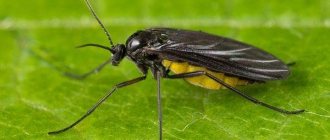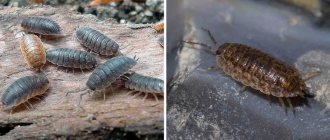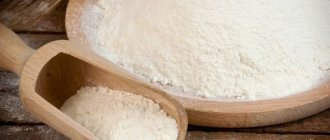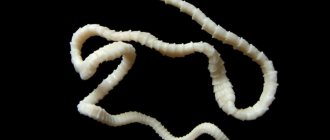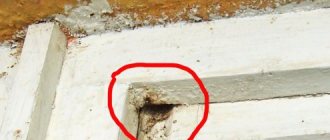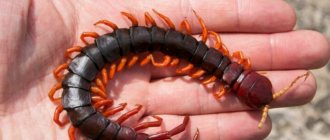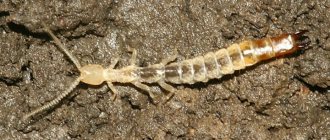How to deal with woodlice in your summer cottage and garden plot
woodlice ( lat. Oniscidea
) not as insects, but as a suborder of crustaceans. In total there are about 200 species in nature.
Woodlice love high levels of humidity, feeding on both living and rotten plants.
Of the entire order of crustaceans, these pests are the most adapted for life on land.
Since wood lice eat exclusively plant foods, they are capable of causing significant damage to garden crops, eating up the roots of young seedlings, destroying leaves and seeds just sown in the ground.
Damage on leaves usually takes the form of through holes, which the pest inflicts while located on the upper parenchyma, since it is not adapted to crawl along the back side of the leaf.
As a rule, woodlice are nocturnal. With the onset of dusk, they leave secluded places in which they hide during daylight hours and go in search of food. During the day, they can be found in fairly damp and shaded places, for example, in the crevices of buildings, under wet stones, under the trunks of old trees, as well as near garbage pits, wells, boreholes and other sources of water. Woodlice can also be found in dense green spaces, including weeds.
Many species of woodlice live off the shores of both freshwater and fairly salty bodies of water.
They also often settle in human housing, settling primarily in bathrooms, showers, and inhabiting damp cellars and basements.
Typically, the size of woodlice does not exceed two centimeters in length, but there are also giant varieties whose length reaches 30 centimeters.
The body of woodlice has a convex oval shape and is usually colored in grayish shades. Visually, the body is divided into several separate segments. In this case, the first thoracic segment covers the head from the sides, the eighth is equipped with a deep posterior notch, and the remaining seven each contain a pair of small abdominal legs.
On the head of the woodlouse there are two pairs of whiskers, one of which is well developed, and the second is underdeveloped. The eyes are located on the sides of the head.
The back contains durable chitinous plates that act as a protective shell. On top they may contain intricate patterns reminiscent of oriental hieroglyphs.
Usually, at a moment of danger, the woodlice curls up into a ring and pretends to be dead.
Unfertilized females contain two openings on the fifth abdominal segment leading to the spermatic receptacles.
Typically, copulation of females with males occurs in the spring with the onset of warm weather, in April or May. At the moment of fertilization, the spermatic receptacles are filled with the seeds of male individuals, burst and enter the oviduct. As soon as this happens, the female’s body structure changes and she molts. In this case, fertilized embryos are transferred to a special chamber, where their further development occurs.
After the release of the offspring, the female molts again, shedding the old skin, and takes on its original appearance.
The life cycle of woodlice is from 9 to 12 months.
What danger do these pests pose?
Woodlice cause the greatest harm to plants that have a shallow root system, including vegetables, ornamental plants and flowers.
They are also able to penetrate greenhouses, greenhouses and greenhouses, where they can cause significant damage to plants.
The pest does not ignore crops stored in cellars and basements, damaging vegetables, tubers, root crops and fruits.
In addition, woodlice are distributors of many dangerous fungal and bacterial infections that infect plants.
Methods of pest control
As with insects, before removing wood lice, it is necessary to determine the cause of their appearance.
If woodlice are found inside a living space, you should carry out a thorough inspection of the house: throw away all old wet rags, thoroughly wash the floor in hard-to-reach places, inspect indoor flowers, and clean kitchen cabinets of missing and moldy food.
Of the indoor plants, orchids and ferns are most often infected.
A prerequisite for the normal functioning of woodlice is the presence of water or a high level of humidity. For this reason, when woodlice are detected, their access to moisture should be blocked. This is especially important when pests infest greenhouses, greenhouses, cellars and vegetable gardens.
To remove woodlice from cellars, quicklime is usually used. It should be placed in low containers, which are then placed on the floor in the most humid places.
If the pest was noticed in a greenhouse or conservatory, then it is advisable to thoroughly dry the soil indoors and temporarily reduce the amount of watering.
To combat woodlice, universal preparations “Mole”, “Ideal”, “Aktara”, “Grom” are usually used, designed to combat moths and ants, as well as gel bait “Schabenge” or “Varan”.
When using chemicals, you must first read the instructions for use of the drugs and in no case exceed the recommended dosage. Otherwise, it may cause harm to living beings and plants. This is especially important if there are small children or animals in the house.
During processing, it is advisable to use gloves and protect your face with a gauze bandage or a respirator.
Folk remedies for pest control
Many homeowners fight woodlice using a solution infused with ground hot red pepper, salt and tobacco. To prepare it, you need to take 3 grams of each substance and then infuse it in a liter of water. This infusion should be sprayed on the areas where wood lice are most concentrated.
Where else can you expect a threat?
Even if you have a dry and well-ventilated home, it may accidentally end up in the path of a pest's migration. How to get rid of woodlice in the house when they appear literally out of nowhere? From the beginning, examine the ventilation (if there is no mesh, it needs to be installed), floor and wall surfaces (cracks - seal) - this is especially true for residents of the first and last floors, to which pests actively migrate from basements and attics.
Installation gaps in the pipeline system are another “window” that pests can use for their migration. And finally, when it comes to penetration from neighbors, even sockets in adjacent rooms can pose a danger if their housing does not fit tightly against the walls of the opening.
Feedback from our client: We have wood lice in our basement. At first, they didn’t pay attention to a private house or any kind of living creature crawling around. And then they snuck under the kitchen sink. We tried poisoning ourselves, the effect was very short-term. We called specialists and they treated the basement and the bathroom and kitchen. Several months have passed already. So far so good.
Woodlouse - description and lifestyle
In nature, it is quite possible to find woodlice in shaded, damp places such as the banks of ravines or damp forest clearings. However, most of all this plant loves to settle near people - it lives in landfills, under fences, near houses and, which especially irritates summer residents, in the garden.
Despite the fact that this plant is low and inconspicuous, with tiny leaves and thin stems, it is a real malicious weed that is very difficult to get rid of.
The fact is that woodlice produces a huge number of seeds - there can be 5-15 thousand of them from one plant! These seeds are perfectly preserved under snow and remain viable for up to five years. In addition, chickweed reproduces well vegetatively - by rooting creeping branched stems, which produce new shoots and roots from each node. In this way, the plant develops from early spring until the onset of frost, giving 2-3-4 generations over the summer and quickly covering your area with a dense “cheerful” green carpet interspersed with white flowers, depriving cultivated plants of nutrition and moisture, deteriorating the condition of the soil and giving shelter to numerous pests.
In nature, in dense grass cover, woodlice cannot withstand competition with powerful perennials, but it really likes beds with loose, moist soil and sparsely planted vegetables. This is especially true in the spring and the habitats of garden crops that germinate slowly.
And also, as we have already written, this plant is extremely shade-tolerant, adapted to both cross- and self-pollination, frost-resistant and unpretentious - what is not an ideal weed?
How to kill woodlice: industrial means
Modern means designed for baiting various types of insects are excellent for getting rid of woodlice. There are currently several types of such substances on the market:
- insecticidal aerosols;
- spray concentrates;
- powders;
- insecticidal crayons (pencils);
- gels;
- sticky traps;
- fumigators;
- ultrasonic repellers.
Insecticidal aerosols
These include a variety of Dichlorvos, Clean House aerosol, Raptor for crawling insects, Combat Superspray. However, these substances are useful only when treating certain areas where large concentrations of woodlice are observed. These drugs are not suitable for ridding the entire house or basement.
Concentrated sprays
The most popular products are called Delta Zone, Taran, Xulat Miko, Tetrixy, Cucaracha, Get. With their help, the premises are treated by many representatives of disinfection services. Using these drugs, you can destroy woodlice over large areas.
Insecticidal powders
These preparations (Riapan, insect repellent Clean House, Fenaxin) are intended for scattering around the perimeter of the premises. The effectiveness of powders is not very high, since not all woodlice prefer to move on the floor. For this reason, their use is advisable only as additional control measures.
Crayons
Such products are ideal for use on vertical surfaces, where wood lice are more susceptible: a large amount of toxic substance adheres to their shell. Crayons and pencils are great as barrier agents that can be used to treat the spaces around where insects enter your apartment.
Sticky insect traps
This option is suitable as a preventive measure and is not used as a primary remedy. Using sticky traps you can catch single individuals, but this will not solve the problem of destroying all woodlice that have settled in the house.
Fumigator
Although fumigators are traditionally used against flying insects, they can also be used to control woodlice infestations. As practice shows, these devices are very effective and allow you to get rid of annoying crustaceans with regular use.
How can you poison woodlice: industrial products in the photo
Ultrasonic repellers are the least effective in combating woodlice, the use of which gives practically no results.
The use of chemicals gives results only after preliminary preparation of the apartment, which involves blocking access to wood lice from external sources. Otherwise, processing will be required more than once.
When choosing and using a chemical to kill insects, follow the basic rules:
When examining the product on the counter, pay attention to its level of safety for people and animals, as well as the absence of unpleasant odors; Before using the drug, read the instructions carefully. If necessary, use respirators and rubber gloves to avoid poisoning.
How to deal with woodlice in garden beds
Beds filled with chickweed indicate fertile and well-moistened soil, but insufficient permeability, severe compaction and poor drainage, and also, possibly, acidification of the site. Therefore, first of all, if you want to get rid of woodlice, you need to try to influence the condition of the soil in the garden.
If the soil in the beds is too acidic, it needs to be neutralized - this, by the way, will only benefit most garden crops. This must be done using so-called deoxidizing agents - wood ash, chalk, slaked lime (fluff), dolomite flour. The application rates for such lime-containing preparations depend on the composition of the soil and its acidity level and are calculated individually each time. The most “strong” deoxidizers are applied only in the spring after the snow melts or in the fall before digging, because they can harm vegetative plants - such agents include, for example, fluff. Other substances, like ash or dolomite, are more gentle and can be added to the soil all year round.
Some green manures can also help to gently deoxidize the soil - phacelia, white mustard, sweet clover and alfalfa. With proper crop rotation, you can even do without using minerals on the site altogether.
If the soil in your beds is constantly waterlogged, you should think about building a drainage system on the site - a high groundwater level and regular flooding will benefit few garden and vegetable crops.
As preventive measures for the appearance of woodlice on the site, it can be advised to observe crop rotation, weed the plantings in time, do not forget to loosen the soil as deeply as possible (to bury woodlice seeds) or use mulch (grass or straw in the beds, black film between the rows), and not the beds should be empty (other fast-ripening crops or green manure can be planted in place of the early harvested crop).
If you already have woodlice thickets, you will have to look for effective measures to combat the weed.
To begin with, you can try to weed out the chickweed. This must be done regularly and carefully, and we must not forget that it easily reproduces even with pieces of stems, so after weeding with a pitchfork, you need to lift and sift the soil so as not to leave even small parts of the weed in it. Not in one weeding or even in a week, but over time you will be able to significantly reduce the amount of weed. Of course, you shouldn’t leave weeded chickweed greens scattered around the site; it’s better to send them to the compost heap.
As the most serious means of combating woodlice, if it cannot be removed from the site by any other means, use approved herbicides - Zenkor Ultra, Lazurit, Fighter, Clorit (spraying vegetative weeds before sowing crops, 2-5 days before crop emergence or in autumn during the post-harvest period).
Roundup , Tornado and Hurricane recommended in many sources for these purposes are prohibited for use in private household plots due to their high toxicity!
If all else fails
It is necessary to turn to professionals if neither chemicals nor traditional methods bring any results. In any city there are a large number of services that deal not only with baiting insects, but also other pests if necessary. Perhaps they advertise near the entrance to the building? If such advertisements are not found in the neighborhood of the apartment, other media will also help.
Professional equipment will certainly make insects leave the house forever. Exterminators use only proven tools.
Woodlice in the bathroom - combating dampness
Insects are definitely transferred from neighbors if even professional sanitary treatment does not help. Then you can try to resolve the issue by teaming up with residents of neighboring apartments. Of course, it will not be possible to reach an agreement with everyone, but we must do everything possible.
In addition, there are other tips. A solution of boric acid can be used to treat woodlice habitats if they are known exactly. Insects can also be caught on potatoes if you cut out the middle of them and leave them in the bathroom overnight.
Simple rules of prevention will also help
It is important to ensure that large amounts of dirty laundry and moisture do not accumulate in the room. Trays of flower pots and vases must be wiped and cleaned regularly
Soil particles and moisture from flowers can also lead to the appearance of unpleasant neighbors.
Professionals use high-quality equipment that does not leave marks on the furniture and has no unpleasant odors. They guarantee thorough treatment not only of the room itself, but also of those places where wood lice come from. On average, the guarantee for such work is given for no more than three months. Re-treatment will be free if the insects appear again.
Getting rid of dampness in the bathroomIt is necessary to separately ensure that the plumbing does not leak. Otherwise, condensation appears, and it becomes a good breeding ground for woodlice. If you cover the walls and floor with waterproof paints, this solution will provide additional waterproofing. The walls can be covered with a special material before the cladding is carried out. In the presence of high-quality ventilation, the microclimate is also improved by “warm floor” systems.
The normal humidity level is 60 percent. Timely repair of plumbing will create the necessary conditions.
Benefits and uses of woodlice
Interestingly, this malicious weed can actually be used beneficially - if you know about its properties.
Remember the story about “you just don’t know how to cook them”? So, chickweed can really be successfully used in cooking. The above-ground green part of the plant (which contains a lot of ascorbic acid and carotene, as well as a rich composition of minerals) is added raw when preparing salads, and when boiled, it is used instead of spinach in vinaigrettes or soups, and served as a seasoning for main courses.
Chickweed can also be fed to poultry (chickens, geese) and animals (pigs, rabbits). In the UK, by the way, this plant is called chicken weed.
Even in folk medicine, woodlice is used as a high-vitamin plant that stimulates the heart and metabolism, has a restorative, anti-inflammatory, antiseptic, sedative, diuretic, hemostatic and wound-healing effect.
And also chickweed, even despite the inconspicuousness of the flowers to the human eye, is a good honey plant - due to its long flowering.
It’s so different, chickweed or chickweed - as you like - it’s like a weed, but it’s also like a useful plant. It’s up to you to decide whether to mercilessly destroy it on your site or use it for culinary or medicinal purposes.
Source
How to get rid of woodlice?
Woodlice is a well-known pest that prefers to live in damp areas. The reason for its attachment to water is that it belongs to the class of crustaceans with the resulting structure and way of life.
the appearance of woodlice does not threaten humans, but such neighbors are not needed
The appearance of a representative of isopods in the basement, bathroom or toilet indicates insufficient waterproofing and ventilation in these rooms and serves as a signal for taking appropriate measures to eliminate excess humidity.
Prevention measures: creating an unbearable living environment
Before starting treatment for the bathroom, it would be useful to understand: what are the reasons for the appearance of woodlice and what do these creatures generally do in a person’s home. The fact is that for a comfortable life of an insect, certain conditions are needed:
- high level of humidity;
- open access to water;
- lack of regular ventilation or poorly functioning ventilation system.
Simply put, this relative of crustaceans (and by calling them insects, we are somewhat sinning against the truth) loves warmth, moisture and the absence of an active flow of fresh air. If this is exactly the situation in your house or apartment, pests will immediately creep into the “resort”. And their uncontrolled reproduction can even cause many serious problems in the future. So, it’s worth repairing the ventilation or installing a forced-air system, dealing with condensation problems on the pipes and replacing ever-leaking plumbing to make your home less attractive to uninvited guests.
Biological characteristics of the pest
Woodlice, like its closest relatives: crabs, shrimp and lobsters, breathes through gills, therefore, being a land dweller, it stays close to water. Tolerates long-term drought thanks to special air cavities resembling trachea. The latter are characteristic of land animals. In 3 months, the crustacean becomes sexually mature, reaching 2 cm in length. Some species of woodlice grow up to 40 cm in the wild.
She, like all arthropods, has an exoskeleton in the form of a chitinous covering of different shades of gray. The shell interferes with growth, so she sheds regularly. 7 pairs of walking legs extend from the body segments, allowing for rapid movement. Long whiskers are designed to “scan” the surrounding space. When in danger, the crustacean twists its body and pretends to be dead.
When in danger, the woodlouse pretends to be dead
Woodlice live on average 9-12 months. They come out of their hiding places at nightfall. They feed on both garden and indoor plants, mosses, bark, algae, musty vegetables and fruits. Damaging plants, they leave holes, and only on the outside of the leaves.
In a city apartment, these crustaceans sometimes inhabit flower pots with loose soil containing fallen leaves and moss. Can damage the roots of orchids, cacti, ferns and other indoor plants.
That's the kind of domestic woodlouse she is. How to get rid of it is a more pressing question.
What kind of insect is this?
Before we describe how we successfully get rid of woodlice from the bathroom, let's first understand how they get there. And at the same time, we’ll get to know these small creeping representatives of the animal world.
Yes, these are animals, not insects. More precisely, woodlice is a crustacean. It is believed that these creatures are older than dinosaurs. And judging by the way they appear as if out of nowhere and multiply quickly, one can believe in their successful life and development over millions of years.
Woodlice is a very small crustacean creature that has 7 pairs of legs. On top it is covered with a shell of dense scales. They do not exceed 1 cm in size. It would seem that what could be so terrible about this tiny creature?
However, entering the bathroom and seeing a swarming carpet of gray bodies on the floor, you feel somehow uneasy. But, according to zoologists, woodlice cannot harm humans. They are non-venomous, do not carry pathogens and do not bite. They're just very nasty.
How to get rid of wood lice in the bathroom?
Constant humidity and lack of sunlight in the bathroom are a fertile environment for woodlice. Here they feed on particles of skin, plaque on tiles, pieces of toilet paper and other things. They are not going to occupy the entire apartment due to the lack of suitable conditions for themselves in other parts of the housing.
Therefore, by tidying up just the bathroom, you can get rid of the unpleasant neighborhood forever. And for this you need:
Proper implementation of these recommendations will allow you to get rid of wood lice in the bathroom forever.
Insecticides against woodlice in the bathroom
Modern formulations that provide high efficiency can also be used to exterminate arthropods. It can be:
What will help in the fight against woodlice?
The above drugs are mostly potent compounds, one way or another, solving the question of “how to get rid of wood lice.” Their use begins with studying the instructions and strictly following all its points, especially those related to dosage, so as not to endanger the life and health of household members.
In particularly serious cases, they turn to professionals for help, who guarantee 100% effectiveness of extermination measures.
Why is inaction dangerous?
People usually start looking for an answer to the question of how to destroy wood lice in an apartment quite a long time after the problem becomes urgent. The search for funds that will help solve it, and not just withdraw money from the homeowner’s wallet, may drag on indefinitely. And during this period, woodlice will already be able to feel like absolute masters of the situation, occupying the toilet, bathroom, kitchen, and sometimes living quarters. But insects, which are generally believed to be harmless, can pose a serious danger with their uncontrolled reproduction.
Experts warn:
Do not delay removing the insect under any circumstances. Moving through the fecal matter of animals and birds, sewers, and boxes of rotting waste, this pest becomes a real sanitary threat to your home. And his “cutest” gift could be E. coli or dysentery, not to mention more dangerous infections.
Folk remedies against woodlice
Folk remedies used:
Garden beds are cleared of plant debris. After harvesting, the soil in the greenhouse is disinfected with insecticides, boiling water and allowed to dry; bleach is used to treat the soil and the frame of the greenhouse.
In difficult situations, you can get rid of woodlice by using proven insecticides of contact-intestinal action, such as:
In the spring, granules of pesticides are scattered between the beds with young plants, which saves their delicate foliage from crustaceans. For safety reasons, pesticides are used strictly in accordance with the instructions supplied with them.
Finding woodlice on a property or in an apartment is a sad event. Resolving the problem may take a while. But if you don’t give up, but persistently and competently clean your home and garden, you can eventually get rid of woodlice.
Source
Reasons for the appearance of woodlice in an apartment
The main reason for the appearance of insects in an apartment is high humidity. Dampness in the room occurs when the ventilation system does not work properly or when plumbing leaks (faucets, toilets, pipes).
Crustaceans also love large accumulations of garbage. A trash can that hasn't been taken out for several days is a great bait for pests. Woodlice are also attracted to dirty dishes accumulated in the sink and wet trays of indoor plants.
Crustaceans are attracted to the apartment by high humidity, including stagnant water in the tray of indoor plants or in the bowls of pets
Folk remedies for woodlice
Woodlice are unpleasant-looking creatures that can take up residence in an apartment and cause nothing but disgust. They are mistakenly (out of ignorance) considered insects. But in fact, these are small crustaceans, distant relatives of crabs and crayfish, representatives of the order of isopods. In other words, woodlice are land crustaceans endowed by nature with gills adapted to breathe air. The only condition is that the air must be humid, which is why crustaceans settle in places where there is sufficient air humidity for them (bathroom, toilet, sometimes kitchen).
Description of woodlice
On average, the size of these creatures reaches 1-2 cm. The body shape is slightly convex, dark in color. The hard shell consists of several segments, each of which has its own pair of legs. The eyes of the crustacean are located on the sides. The antennae on the head roughly correspond to the length of the body. Woodlice do not have claws or tentacles, like their relatives. On the abdomen there are gills, with the help of which the crustacean breathes. At the moment of danger, the woodlice curls up into a ball, surrounding itself on all sides with a reliable shell, while the soft abdomen and head are inside such a ball.
The female carries the offspring in a special pocket on her chest, where the eggs mature and new individuals are born, not in a hurry to leave the pocket until they grow up.
Lifestyle is nocturnal. During the day they hide in dark places, as they do not like bright light. They live on average 9 months to a year, and can be found in any climate zone.
Woodlice do not parasitize humans; their diet has nothing to do with humans. Their diet consists of human food remains in the trash can, mucus in bathrooms, dust, rotting parts of plants and spoiled fruits. With a large number of crustaceans, when there is not enough food for everyone, healthy plants are used.
General description of insects
Woodlice are classified as a suborder of crustaceans. Under natural conditions, these small pests reproduce and live in rotten wood and damp litter. They do not pose any particular danger, but the very proximity to these creatures causes disgust and hostility.
Their activity peaks in the spring and autumn months. They breed in the summer. In this case, the female keeps the eggs in a special sac attached to her body. She moves with him from place to place until she finds a place that is safe for the development of larvae. It is easy to distinguish these insects by their appearance. They have a rounded body, which is divided into sections:
- head;
- chest;
- stomach.
What is surprising is that these creatures breathe through their gills. During their existence, woodlice have managed to adapt to land conditions.
Preferred Habitats
Having discovered woodlice in their apartment, many often wonder: where did these creatures come from in the house? In fact, there are several ways for crustaceans to penetrate human habitation:
Once in an apartment, crustaceans immediately look for places where their habitat would be comfortable. These could be flower pots, places under sinks and pipes in the bathroom or kitchen, in the toilet, or in garbage bags. If the house has a cellar, this is also a suitable place for woodlice, since it is almost constantly dark and damp.
In addition to apartments, woodlice live quite comfortably in nature:
As already mentioned, woodlice do not parasitize humans. The harm they can cause to people is the transmission of diseases. Fungus, lichen, various kinds of bacteria (when they enter the house from garbage heaps) - this is not the entire list of diseases that woodlice, which are harmless in themselves, can give. Nervous breakdowns are also possible for those who are especially afraid and generally cannot stand being in the vicinity of insects and other “non-domestic” small creatures.
This is quite enough to understand how necessary emergency disposal of woodlice is.
Meeting with the terrible
A year ago I moved to my apartment in an old building. It was an ordinary one-room Khrushchev house, but I was quite happy with the space, because I was going to live alone, and I, a young girl, didn’t need much. Most of all, I was fascinated by the thought of the upcoming renovation: finally, the interior design would be the way I wanted.
The renovation took a little over two months. With a good person who is well versed in all sorts of construction and improvement subtleties, we put the apartment in order every day.
So, the wallpaper is pasted, the linoleum is laid. Ahead is the purchase of furniture. I come home one gloomy August day, go into a more or less furnished kitchen, turn on the light and see some unknown creeping creature with a grayish back, a bunch of legs and long antennae moving across the floor. I thought that the insect wandered in by chance from the street, because it’s summer - there are a lot of them there. Having mercilessly crushed the creature, I walked around the apartment, figured out what would stand where, and went to spend the night with my mother.
A few days later I came home again. Exactly the same insect was crawling across the room in the direction from the front door to the window. "Ugh!" - I thought and crushed it again.
Then I furnished the apartment: I bought a slide, a large wardrobe, a sofa and moved. On the first day there was a lot to do, I had to wipe off dust here and there, so I went to bed late. Before going to bed, I went to the bathroom, and then a real nightmare happened: a multi-legged gray creature was sitting right on the snow-white bathtub. I washed it off with a shower, changed my mind about washing and turned to Google. My request was: “Insects that live in the apartment.”
Editorial opinion Elena Kalita Magazine editor
When woodlice appear in an apartment, the sanitary condition of the room suffers, so you shouldn’t even try to coexist with them. You should get rid of them as quickly and decisively as possible after they are discovered.
I missed the part of the article about cockroaches, lice and bedbugs and saw a familiar “face”. It turned out that woodlice lived in my apartment. What did I manage to find out about the “neighbors” that night?
- Firstly, these are not insects, but small crustaceans.
- Secondly, they are often confused with silverfish - even more vile creatures with long mustaches both in front and behind.
- Thirdly, they love humidity. The places where they accumulate are secluded corners in the bathroom or under the kitchen sink.
Internet resources said that they do not disappear on their own and need to be removed. Without thinking twice, I bought a can of repellent for crawling insects from a nearby store, sprayed it under the bathroom and calmed down a little.
In the morning I found a couple of corpses on the tiles in the bathroom, disgustedly threw them into the toilet and thought that everything was behind me. But it was not there!
How to get rid
Before taking direct measures to destroy woodlice, you need to carry out preparations consisting of several steps:
Completing these steps will help prevent further woodlice from entering your home, after which you can begin the destruction itself. It is not necessary to use chemicals for this. In the fight against woodlice, it is quite possible to use folk remedies, since these crustaceans do not have a high degree of survival (compared, for example, with cockroaches).
Destroying insect infestations: where to start the fight
Killing woodlice is difficult. If you want to get rid of insects in your home yourself, take a comprehensive approach to solving this problem.
Carry out a general cleaning, after which try to reduce the humidity level by using dehumidifiers, air conditioners or fans.
Repair any devices that are leaking water.
Pay attention to the flower pots. It is quite possible that plants will need to be replanted to replace soil affected by woodlice.
Protect your home from woodlice entering from outside
To do this, equip the ventilation holes with a mesh with small cells.
Seal cracks in ceilings and walls, and remove gaps around water and sewer pipes. You can cope with this task using polyurethane foam.
Then you can begin to destroy the pests that have already settled in the apartment.
Traditional methods of fighting woodlice
Any folk remedy is good not only because of its effectiveness, but also because it is absolutely harmless for humans and their pets.
However, boric acid occupies a special place in the fight against woodlice. This cheap and widely available product can be easily purchased at a regular pharmacy. Boric acid is sold in powder and liquid form.
Boric acid can be used in different ways:
The photo shows the method of preparing bait
Just like the previous methods, boric acid is safe for humans.
The harm that woodlice can cause to people
Anyone who is wondering where silverfish could have come from in an apartment can be answered that there may be several sources of infection in a living space. The places and reasons for the appearance are as follows:
- Dampness. And not only in the apartment, but even in the basement, cellar, sewer channels of an apartment building, or in the attic.
- Ventilation. Woodlice can easily live in ventilation ducts, and if they sense that there is something for them to profit from in your apartment, then they will definitely choose some place in your home.
- They come from the garden along with bringing crops to the apartment, for example, or work clothes.
- Bin. If the garbage in the apartment is not taken out for a long time, then this serves as a real bait to attract such individuals into your home.
- Rotting fruits, vegetables and other organic matter.
- Standing, rotten water in buckets or other containers.
- These are, first of all, carriers of viral and infectious diseases.
- They spoil food by accelerating the process of breakdown, oxidation and rotting.
- If you choose a flower pot with an orchid and other similar plants, they can cause the stem and roots to rot.
- When settling in the soil with seedlings or other plants, they compact it and disrupt air exchange.
- Capable of carrying fungal and mold spores on their paws.
Therefore, seemingly harmless woodlice are not such innocent creatures at all. Therefore, you should listen to further recommendations from specialists to avoid such problems.
The most common places where woodlice are found in an apartment are the kitchen and bathroom, due to the constant presence of two factors:
- High humidity. The accumulation of condensate is an ideal condition for the development of crustaceans;
- Availability of food. A trash can is an optimal environment in which food waste necessary for life is constantly present.
In addition to the listed places, woodlice can be found in flower pots, where there is not only a humid environment, but also fallen leaves. The main condition for the development of uninvited guests is high humidity, therefore, eliminating this factor will get rid of woodlice.
Wood lice that have settled in the bathroom do not cause any particular harm. Their appearance is more than unaesthetic, but at the same time they are not aggressive, not intrusive, like some buzzing flyers, do not bite and are not able to penetrate the skin, and therefore cannot “reward” a person with dangerous diseases.
The fight against woodlice is carried out due to the fact that the proximity to them is unpleasant, especially when there are a lot of these creatures. In addition, the realization that some time ago these creatures lived in a dirty basement among rat and mouse excrement only encourages us to take action as soon as possible. This is where the owners begin to look for effective means that will help remove all small crustaceans from the bathroom.
